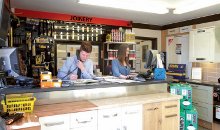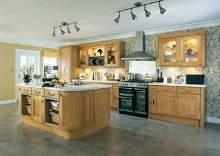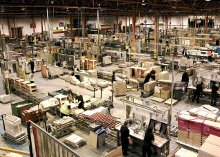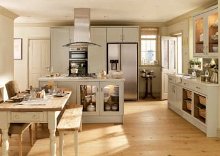Onwards and upwards
10 December 2012Howden Joinery has defied recession and is continuing to grow at a rate of knots. Sally Spencer reports
To say that Howden Joinery Group is on an upward trajectory would be something of an understatement. The company was founded in 1995 with just 14 outlets in London and the south-east, and in the intervening 17 years it has grown at the rate of around 30 depots per year.
Its depots now number 520 - and counting - across England, Scotland and Wales and it accounts for more than 20% of Britain's kitchens market. It employs around 6,000 staff (4,500 in the depots, 1,000 in manufacturing and 500 in support functions) and this year's turnover is approaching £900m (2011: £854m).
Howden Joinery began life with a proposal from former Magnet Trade managing director Matthew Ingle that the then MFI group set up a trade-only kitchen supplier. MFI bought into the idea and the business was established with a small range of kitchens.
"There were just eight in the range at that time," said head of investor relations Gary Rawlinson. "We were selling direct to the small local builders who at that stage were supplying private and public sector landlords. The owner/ occupier market would have required a bigger range but it wasn't something we envisaged our builder customers supplying into at that point."
A year or so later a second wave of depots was opened and the decision was made to target nationwide coverage. And just as the company's depot network has grown, so too has its ultimate customer base.
"Over time our builders' client base has expanded such that they are now serving owner occupiers as well as landlords and our sales today are probably 75% to the former and 25% to the latter," said Mr Rawlinson.
"The market itself is being driven by kitchens becoming more complicated. The idea of doing it yourself is becoming less of an option so more and more people are turning to builders. And builders have told us that we are instrumental in this as they now have more confidence to supply owner occupiers because they have us behind them."
Howdens' corporate headquarters are in central London, but the engine rooms of manufacturing are in the north of the country, closer to raw material supply. The company uses 200,000m3 of chipboard every year - "10% of the UK's chipboard capacity".
Egger was the sole chipboard supplier but this is being split "by mutual consent", with Egger supplying 18mm chipboard for boxes (carcasses) and Kronospan supplying 38mm board for worktops, both from their UK plants.
The company manufactures around a third of what it ultimately sells (kitchen appliances, fixings, joinery products and fascias are bought in) and does this from large factories in Runcorn, Cheshire and Howden in east Yorkshire.
The Runcorn site is a traditional integrated 500m-long manufacturing facility. Chipboard, laminated top and bottom, is taken in one end, then cut, drilled and edge-banded before being assembled into boxes and stored in the factory's warehouse where stock is turned over every two to three days.
The Howden site is "half a mile wide and half a mile deep" and is divided into different manufacturing units.
Manufacturing centres on worktops and boxes - three-and-a-half million of the latter each year. Runcorn currently produces the lion's share of the boxes - three million of the most standardised models per year - while Howden produces the "fancier" smaller volume boxes, worktops, architraves, skirting boards and some of the more basic fascias (cabinet doors).
Change is in the air, however. "We need to think about our capacity and we've decided to even it out a bit more," said Mr Rawlinson. To that end, the company is halfway through a twoyear £20m project to install a new production facility, supplied by Italian furniture machinery manufacturer Biesse, at each of its factories.
The depot network is supplied direct with worktops and boxes from the factories' own warehouses, while everything else that makes up a kitchen is distributed to the depots from a huge warehouse - "getting on for one million ft2" - in central Northampton.
Product design
Two-thirds of Howdens' offering may be bought in from external suppliers but everything, from fascias to appliances and internal doors, is designed in-house.
"What works for us as manufacturers are large volumes, long runs and relative simplicity," said Mr Rawlinson. "We only sell two types of boxes, white and light oak, but there are 40 different styles of fascia and it makes sense to go to specialists for those. We source products internationally and have close relationships with a global network of suppliers."
Product design is an interactive affair. "We have a product design and development department of around 15 people but the process of coming up with a new product is much bigger than that," said Mr Rawlinson. "Our product development and design team will spend a lot of time with the depot staff, finding out from their interaction with the builders where they think the gaps in the market are.
"We also keep a close eye on what other people are selling, go to major industry exhibitions and work with a more generic design consultancy looking at general trends that might influence kitchen design."
Howdens' designers then come up with prototypes that are shown to depot managers and kitchen planners for their feedback at special events in the run-up to the new season.
"We feel we're leading the kitchen market rather than just responding to it so we aim to refresh the offering typically by six or seven new ranges each year," said Mr Rawlinson.
Recent trends are high-gloss finishes and "slight movements in colour ways".
"People are quite traditional but we have seen a slight broadening of the creams and wood shades into greys and pastels," said Mr Rawlinson. "And curved fascias and integrated handles are also becoming very popular."
While fashions change, Howdens' route to market has not - and nor will it.
"We do a flat-pack box if someone wants a very, very low cost kitchen but it accounts for less than 1% of our sales," said Mr Rawlinson. "Our boxes are factory-made and rigid - much better quality than anyone can make flat-pack. Although a rigid box is more expensive than a flat-pack box it cuts down on labour, so from the perspective of the builder and the end user, it makes the job much easier."
The Howdens/builder relationship is entirely symbiotic, he added. "We're dealing with 300,000 small, local builders whose business depends on their reputation. We provide all the support they need to project manage and install a kitchen - the brochures, the planners, the quality products - and help them make good their reputation and thereby earn a living."
The builders also appreciate the depot staff's product knowledge and the fact that they get to know them all on first name terms and build up a rapport with them. In return, said Mr Rawlinson, because of the service and support the depot provides, the builder ends up as a "semi-Howdens sales person".
The company operates what it calls "no call back quality", by which it means that if a product needs to be changed for any reason, even if it's just customer whim, it's done so without question. This is possible because all depots hold all the stock all of the time and is a huge benefit for both builder and end customer, neither of whom wants a job interrupted for weeks for the sake of switching from a 300mm to a 600mm box which is on back order.
It's also possible because of the level of autonomy Howdens affords its depots. From day one they've been set up to be run by their managers as if they were their own business. They take responsibility for what they display in their depots because it has to suit their own geographical market, and they set their own prices and discount structures for their account holders. Eighty per cent of the company's builder customers have a credit account.
"The managers are extremely entrepreneurial and are incentivised to develop their depots by rewards and bonuses based on their profitability," said Mr Rawlinson.
"They are rewarded well but are expected to deliver," he added. "For example, October is our busiest month, with twice as many sales as any other month. The last week in October is absolutely manic with our staff working 80-90 hours because the mindset is to work what is necessary to make sure every last customer is served. They don't get paid overtime but they get a very good bonus and exceptional performance is recognised."
That and the career opportunities make employees very loyal to Howdens and staff turnover is low as a result, he said.
Continued growth
Despite the wider economic gloom Howdens still sees "massive opportunities to continue growing just by doing what we're doing".
A 700-depot target derives from a pragmatic view, said Mr Rawlinson. "We can see ourselves moving to 700 over the next five or six years but when we get closer to it we'll probably have a rethink". By which he means the target could be revised upwards, not downwards.
The general feeling is that the market is still contracting, he said, but the potency of Howdens' offer and the fact that it has the attitude that in difficult times it doesn't respond by looking at where it can make savings but at how it can get a bigger share of a shrinking market, will see it continue to flourish.
"We'll continue to focus on delivering products and services that the market wants and that work for the builder," he said.



